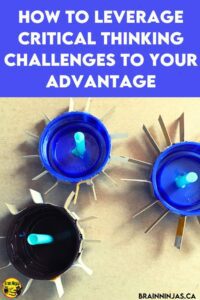
What do you do when you want to challenge students, but you also want them to learn? We give them critical thinking challenges. Critical thinking requires many skills-problem solving, collaboration, design thinking, and perseverance. When a critical thinking question is carefully crafted, you can get students to explore learning outcomes while having fun and being engaged in their learning at the same time.
Why do you want to challenge students?
It has been our experience that when students are given the chance to play they learn quicker and remember what they have learned longer. By the time students get to grades four and five, there just isn’t as much time to play as there is so much more information to cover and master.
This is where critical thinking tasks or challenges can be helpful in your teaching.
Students need help learning how to learn. They need to understand that not getting the answer right away is actually the learning process and by continuing to work through a problem helps the brain learn.
We use a method called The Learning Pit to teach the concept of letting students struggle with a problem until they solve it. You can read more about that lesson in this blog post. It comes with a lesson you can use with your class and it pairs very well with the critical learning challenges included in this post.
We also challenge our students because the activities are very engaging. Students love doing these challenges because it feels like play (but the science says it’s learning).
How do you create a critical thinking challenge?
In order for a challenge to be successful in your class, you first need to have a conversation with your students that you are intentionally giving them a difficult task to see if they can figure it out. The task is not meant to be a quick activity that only takes a second to solve. It is meant to be something that you will have to work on for a few minutes all the way up to an hour.
We can send you a PBL Planning Checklist that we use when we are starting to plan challenges in our classroom. It can be found in our Resource Library, along with many other general classroom forms to help you organize your classroom. Or, we can send a copy directly to your inbox when you sign up for our email list.
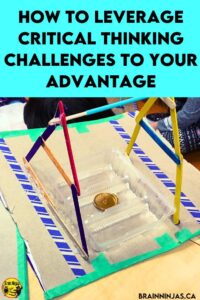
The Problem
Create a problem students need to solve. Relate it to your learning outcomes when possible. This usually works best as a question. For example: Can you create a windmill that powers itself? An even better question might be: How many different ways can you power a windmill without a battery?
An open-ended challenge leaves students open to making or creating anything. The goal is to have students feel like they can create anything, but still keep it aligned with a specific problem.
The Materials
Give your students the materials they will need to solve the problem/access to materials they choose. We try to use materials that cost nothing and can be reused. Our goal is to not create more garbage by using materials that could be recycled until they are destroyed by a project. For example cardboard, dowels, plastic lids, tape, glue guns etc. We encourage our students to disassemble their projects to recycle or reuse parts when possible.
If you have access to materials like blocks, Lego, Makey Makey or other coding style products you can use some of these to create virtual projects that you photograph to keep (instead of the project itself).
The Time
Give your students time. Time to plan and think and test and retest and collaborate. For example: Meet with your group and come up with a plan of attack. When you have a plan you can come pick out the materials you need to start building. You’ll have two hours to work on this challenge today.
This is the part that many teachers struggle with. It takes time to collect the materials and it takes time to clean them up at the end of the project, but this time is well worth it as the learning gained far outweighs the mess. Use the time your students are working on their projects to ask questions, see what they know, see what they don’t know and observe how they approach the problem.
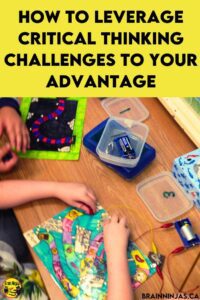
The Feedback
Give your students feedback. Ask them what they can do to make it better. For example, your windmill turns, but it keeps getting stuck. What can you do to improve how smoothly it runs? Take the next thirty minutes to see if you can resolve it. Students need to be given time to reflect on and use the feedback.
Don’t save your feedback for the end of the project. Give your feedback as they are working. This will give them time to actually refine and make changes. Feedback doesn’t help when it’s given at the end. Let your students use your feedback to move their learning forward.
The Collaboration
Encourage students to teach others. Encourage them to learn from each other. For example, I love that your axle turns so easily. Can you show the class how you made it?
When your students ask how to do something, first ask the class. Say, “This student wants to know how to do… Who can help him out?” You’ll have all kinds of hands up in the air. We call these students experts in our class. Lots of students are experts in lots of different ways. Students can be experts in anything from how to save a document to how to build a pulley system. We even had an official “where to hand things in” expert whose sole job was showing people where to hand in their work for an entire week.
Allowing your students to collaborate will save you time. Instead of thirty questions for you, your students can take on those questions and learn from each other.
The Responsibility
We put our students in charge of the class. They lead the clean-up at the end of our learning time. This is not accomplished the first few times on their own. We teach students how to clean up and then they take over.
Our Routine
- return borrowed materials (scissors, glue guns, rulers or anything else that doesn’t belong specifically to a student)
- pack up projects (We keep a set of boxes that fold up when we aren’t using them. These are the perfect size to place any half-finished projects.) Finished projects are placed on a specific shelf or table.
- clean up unused materials (these are all the pieces that students took thinking they might use them, but didn’t. It also includes cleaning up the places where borrowed materials came from.)
- Floors. We bought brooms and little dustpans specifically for our students to use. They know to sweep up their areas and leave the room clean so our custodians don’t have to do extra work.
We have already started writing critical thing challenges related to science learning outcomes. If you would like to give them a try along with some helpful tips, student examples, and marking guides you can find them in our store. We’ve tried to make them accessible to regular classrooms using minimally priced materials.
What are some ready-to-use critical thinking challenges?
Chemistry Critical Thinking STEM Challenges
Once your students have some basic terminology about classroom chemistry, let them experiment to try to answer some questions in this set of critical thinking challenges.
These are designed to be done in a “one a day” style, but we’ve heard teachers use them as stations and do them all in a single day! All the experiments use materials found in your kitchen cupboards or on your cleaning shelf.
Find the Chemistry STEM Challenges in our TpT Store ($USD) or our BN Shop ($CAN).
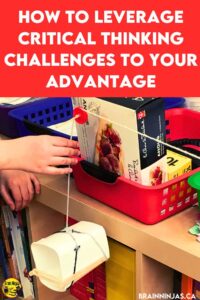
Design a Carnival Attraction STEM Challenge
Students can use what they have learned about simple machines to see if they can create a carnival attraction like a Ferris wheel, roller coaster or swinging ship. We even had students create a hot dog cart one year!
This challenge has been so popular with our students over the years that they start showing us their plans months before we even start the unit. Most of the activities involve understanding how a wheel and axle work and then applying it to their project. We use materials from the recycling bin for these projects.
Find the Simple Machines Design a Carnival Attraction STEM Challenges in our TpT Store ($USD) or our BN Shop ($CAN).
Structures and Materials STEM Challenges
Students get to build all kinds of structures that are tested against different things like weight, height and durability.
These challenges can be done at the beginning of a building unit, during the unit to teach specific ideas or at the end to see what students have learned. Students can make these projects as simple or complex as they wish. We’ve used these tasks with students as young as grade three and all the way up to grade six.
Find the Structures and Materials STEM Challenges in our TpT Store ($USD). It is not available in our BN Shop ($CAN) yet.
Design an Electrical Game Board STEM Challenge
In this task, students have to create a question and answer game where they can check if their answer is correct by checking to see if it completes an electrical circuit and makes a light bulb light up.
These games just need some card stock, tape and tin foil to make the games work, but you will need to have access to materials to make circuits such as wires, light bulbs and batteries. This activity is one we do every year because it is so popular!
Find the Design an Electrical Game Board STEM Challenge in our TpT Store ($USD) or our BN Shop ($CAN).
Simple Machines STEM Challenges
These little challenges are quick and for the most part simple. Students use what they have been learning (or are going to learn) about simple machines.
The majority of these tasks use simple things like rubber bands, craft sticks, thread spools and plastic utensils to make things like levers, catapults, and pulleys. These are the perfect little activities to do in between lessons or turn your whole afternoon into an exploration session.
Find the Simple Machines STEM Challenges in our TpT Store ($USD) or our BN Shop ($CAN).
Electricity Critical Thinking STEM Challenges
These challenges use skills and knowledge from a unit about electricity. Students have to construct different types of circuits using different materials to accomplish different tasks.
Most of the tasks just need materials to create circuits like wires, batteries and light bulbs. Some of the activities also need a little bit of cardboard, tape, tin foil and odds and ends like clothespins.
Find the Electricity STEM Challenges in our TpT Store ($USD) or our BN Shop ($CAN).
Astronomy STEM Challenges
These challenges use skills and knowledge from a unit about astronomy. Students have to design equipment to help make life in outer space or on different planets possible.
These tasks are a little different as students may not be able to test all their prototypes (because accessing space is a challenge for most classrooms) but we’ve included some suggestions on ways to work around this.
Find the Astronomy STEM Challenges in our TpT Store ($USD) or our BN Shop ($CAN).
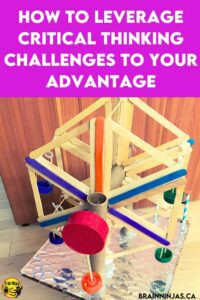
Makerspace Critical Thinking Challenges
These little mini-challenges are just quick activities you can do in your classroom or in your makerspace if you have one. They are designed to use and reuse materials over and over again while allowing students to explore different ideas.
Find the Makerspace Critical Thinking Challenges in our TpT Store ($USD) or our BN Shop ($CAN).
If you have Lego, craft sticks, cardboard, bottle caps or pretty much anything you’ve been collecting, students can try to do tasks and then disassemble them to reuse all the pieces. These make great stations, too!
Need more information about makerspaces?
We have these posters for your makerspace to inspire your makers. You can find them in our Resource Library if you’re already a ninja. Not a ninja? Don’t worry! We can send them straight to your inbox when you sign up for our email list.
Critical thinking challenges help teach students skills they can use for project-based learning. Learn more in our posts The Reasons for Project Based Learning and How to Keep Students Accountable During Project Based Learning.
Do you use projects in your classroom? What about challenges? What do you think the advantages or disadvantages of this type of learning can have? Let us know your thoughts in the comments below. We’d love to hear from you!

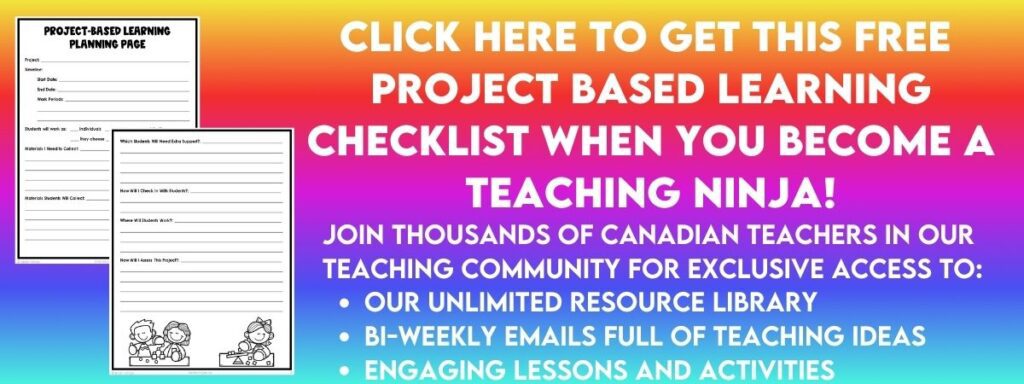
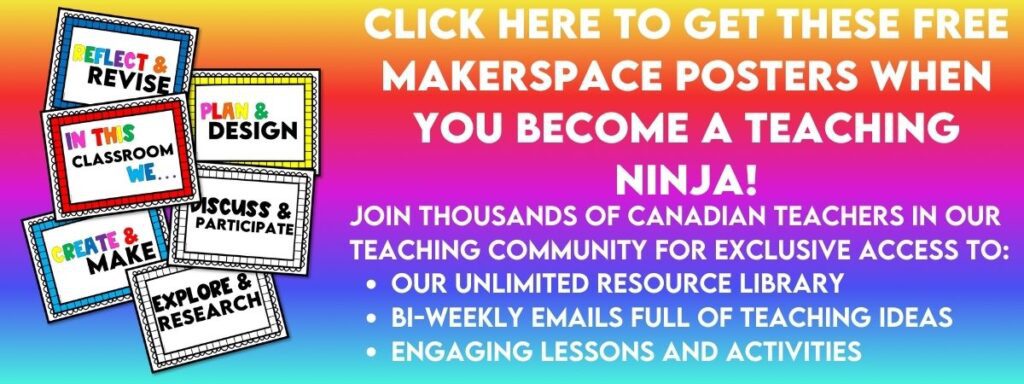






Fantastic and helpful material. Thanks